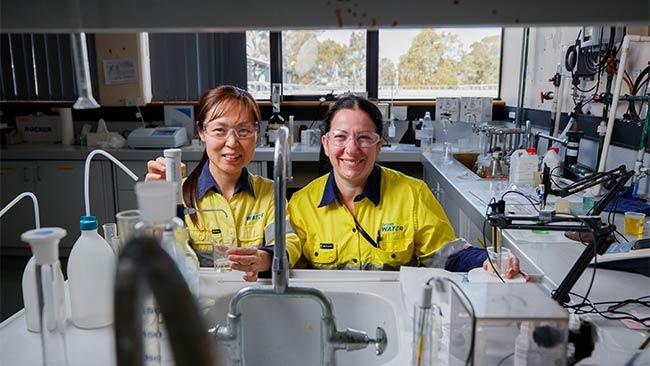Meet the unsung heroes producing safe drinking water for Sydney
The water we drink goes on an incredible journey before it reaches our taps. These two water experts play a vital role in keeping our city thriving.

NSW
Don't miss out on the headlines from NSW. Followed categories will be added to My News.
Daily Telegraph and Sydney Water have partnered to save water.
If there are two people you know you can trust with your life, they’re Jennifer Hill and Haixiang Wang.
Like most people, they go to work and tackle a regular eight-hour shift every day, but what these women do is crucial to the future of our city’s water supply. Without people like them, it simply wouldn’t be the same.
The women have a combined work experience of almost 40 years at Sydney Water, playing important roles in the Water Supply and Product team at Orchard Hills Water Filtration Plant. Every day, they monitor and produce quality drinking water to more than 4 million people living and working in the Greater Sydney area.
“We do our best to optimise our processes to give our customers the best drinking water we can… that’s our core business, that’s what we come here for. Water is our number one priority,” said Ms Hill.
Navigating new challenges
As a Senior Production Officer, Ms Hill works with a team to operate and maintain the plant, producing high-quality drinking water and meeting product requirements in all conditions. Over recent years, that has included extreme drought, unprecedented bushfires, significant rainfall and floods, and a pandemic.
The joys of their job are not without challenges and no two days are the same.
“The water quality can be quite variable with wind and weather condition changes,” said Ms Wang, who works as the Operations Team Lead. “The plant has to be on top of everything with the treatment process and chemical dosing, to ensure the process goes smoothly and we are supplying water reliably and safely.”
Right now, the duo are doing their best to ensure severe weather events won’t dampen their efforts.
“No-one understands the hoops we’ve gone through, and the lengths we’ve taken to provide the water quality we produce every day,” Ms Hill said. “We want to make sure our customers aren’t impacted.
“We really take pride in what we do because we’re committed to what we do. I want that to be presented to customers so they understand and appreciate [what] comes out of their tap.”

Making every drop count
Recent weeks have seen tremendous amounts of rainfall over huge areas of New South Wales. In addition to causing dangerous floods, the deluge caused significant amounts of debris to flow into water catchments.
At Warragamba Dam, for example, situated 65km west of Sydney’s CBD, experts say only 15 metres of the dam’s 60-metre depth is currently suitable to be cleaned and turned into drinking water. Every drop is run through a meticulous filtration process that starts by removing large contaminants such as twigs and leaves. From there, it’s screened through tightly packed beds made from sand and anthracite, carefully checked to ensure it meets the right standards (including pH), disinfected with chlorine, and pumped into reservoirs.
The idea that full dams means the general public doesn't have to worry about conserving water is a widely perpetuated myth, but experts say it’s inaccurate. Severe weather events means everyone has to play a part.
Easiest ways to start saving water
As a starting point, Sydney Water recommends taking shorter showers, using the half-flush button on the toilet, and filling appliances such as dishwashers and washing machines all the way before running them.
However, there are lots of other highly effective ways to save water at home.
For example, a single leaking tap can waste up to 2000 litres a month. Even if you can’t hear drips, it’s important to check your meter and your bill to make sure you’re using a normal amount of water for a household of your size. If the numbers don’t match, it’s worth asking a plumber to investigate.
Some homeowners may be eligible for PlumbAssist support, which is a free service that helps take care of essential plumbing such as repairing or replacing broken toilets, taps, showerheads, and pipes.
Another important step is to set a target for your daily household water use. You can check your bill for a starting point and then keep an eye on your meter to keep track of how much water you’re using.

Future of Sydney’s drinking water
Sydney has some of the best drinking water in the world, thanks to the efforts of experts such as Ms Hill and Ms Wang. While they both enjoy their jobs, the responsibility isn’t something they take lightly.
Millions of people depend on their ability to produce exceptional water, come rain, hail, or shine. It’s an essential service that helps us maintain healthy bodies, clean our homes, operate our businesses, cook our food, keep our gardens fresh, help us cool down during the hot summer months, and much more.
For Ms Wang, the motivation to keep going - no matter what - is simple.
“Knowing that we are supplying 85 per cent of our customers every day makes us proud,” she said.
Sydney Water is investing in your future, committing today to a better tomorrow. Together we can save water. Learn how you can help.
Originally published as Meet the unsung heroes producing safe drinking water for Sydney


